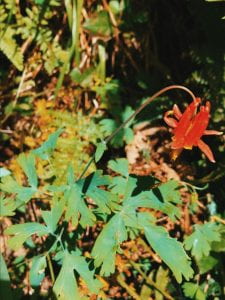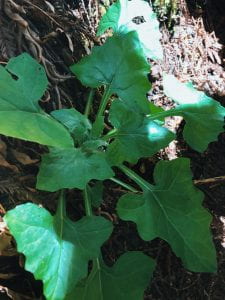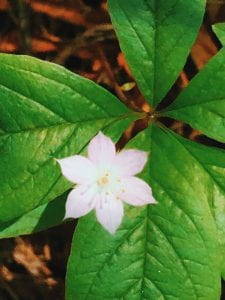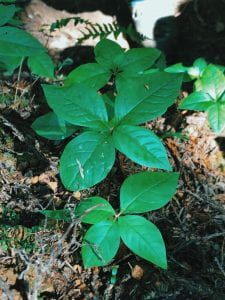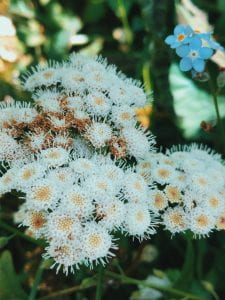On May 2nd, our botany class visited Mt. Tamalpais once again to complete our elevational transect, this time hiking from Pantoll to Steep Ravine. The majority of our hike was through a redwood forest, which help create a mostly shady habitat. Even so, there was a decent amount of light breaking through the gaps in the canopy. Generally, lilies and ferns were incredibly common in the shady and moist soils of the forest understory.
One of the species we observed was the red columbine (Aquilegia formosa), which is a perennial herb belonging to the Ranunculaceae family. Its basal leaves are deeply 3-lobed. Its flower consists of many stamen, 5 red outwardly-spreading sepals, and 5 yellow-orange petals. Its petals bear nectar-containing spurs which attract hawk moths, butterflies, and hummingbirds. The red columbine prefers to grow in the moist soils of a variety of habitats, such as streambanks, woodlands, and chaparral.
The trail plant (Adenocaulon bicolor) is a perennial herb which can be found throughout western North America. This plant belongs to the Asteraceae family… The leaves of the trail plant are pinnately veined with deeply chordate bases and acute apices. The underside of the leaves exhibit prominent venation and are grey-green in color. The leaves are attached by long and thick petioles. Additionally, the leaves are palmately compound, all growing from a single origin. The leaves are ovate-triangular in shape, resembling arrows and giving it its name. The trail plant generally prefers to grow in moist and shady understories.
The Western Starflower (Lysimachia latifolia) is a low-growing perennial herb that can be found throughout Western North America and belongs to the Myrsinaceae family. Its 4 leaves are arranged in a whorl and are ovate-elliptic with acute apices. The leaves also exhibit pinnate venation. The flower is bilaterally symmetrical and has 6 petals, which are light pink in color with a white center; the petals also have acuminate apices. The flower has 7 stamen. The Western starflower generally prefers to grow in moist and shady slopes.
Trip Summary: This trip was another beautiful hike – we mostly walked through the understory of a redwood forest which meant it was a cool and shady hike. At some point we had to descend a 10-foot ladder – thankfully, it was pretty stable and we all made it down without incident. We also saw a few fallen redwoods whose branches became fully grown redwood trees. We also saw a bunch of redwood trees that had been hollowed out due to fire – the insides of the trees were actually pretty spacious. Worst case scenario if I can’t figure something out after graduation I can just take up residence in one of the hollowed-out redwood trees. At the end of our hike we were greeted by a beautiful view of Stinson Beach.
Honorable Mention Species


